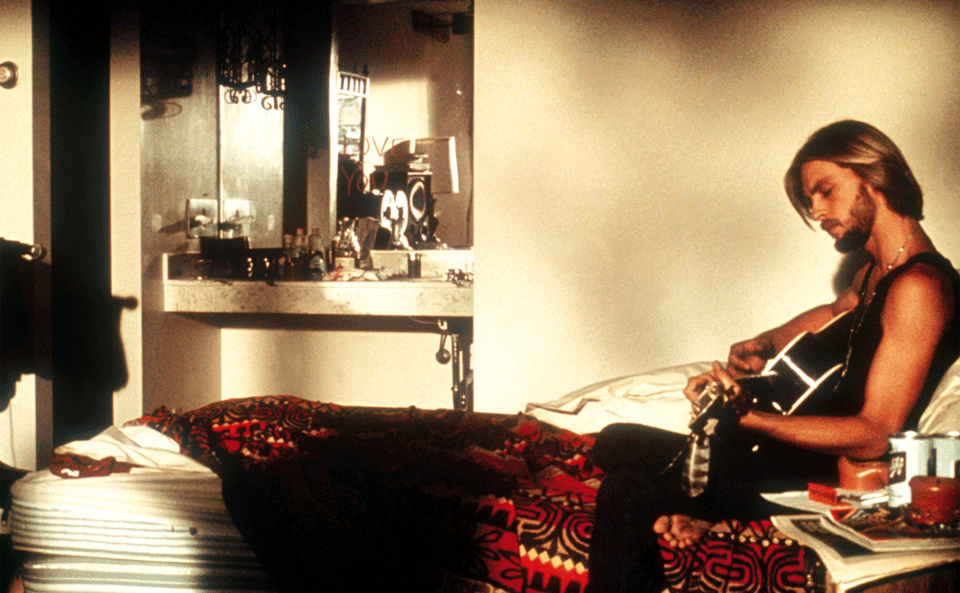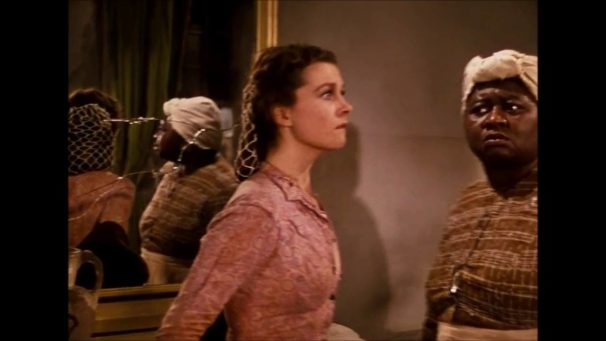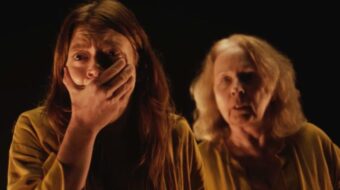
Nashville: Plot spoiler alert!
After viewing Father Goose at the TCM Classic Film Festival I decided to watch Nashville, which was also being screened in the Chinese Multiplex #1 filled with theatergoers. I hadn’t seen Robert Altman’s magnum opus again since its 1975 release. I stumbled upon Jeff Goldblum and other cast members as they entered the roomy theater and upon recognizing Keith Carradine, I declared: “Preacher Casy rules!” Of course, this referred to Keith’s father, the great character actor John Carradine, who perfectly depicted the clergyman-turned-union-organizer in John Ford’s 1940 classic adaptation of John Steinbeck’s Dustbowl and beyond masterpiece, The Grapes of Wrath.
The still-handsome Keith’s eyes seemed to light up, but then I ruined the moment by adding: “And you were great in Gauguin the Savage,” a 1980 TV movie that’s one of the best screen versions of the post-Impressionist painter’s life in Polynesia. Still smiling, without missing a beat, Keith politely informed your imbecilic know-it-all would-be film historian: “That was my brother,” David Carradine, best known for the popular 1970s Kung Fu television series and features such as 1976’s Bound for Glory, where in a bit of canny casting Preacher Casy’s real-life son portrayed another Depression-era union hero, Woody Guthrie.
Goldblum, Carradine, screenwriter Joan Tewkesbury and Ronee Blakley spoke in depth before the screening of the two-hour, 40-minute movie. Toward the end of the informative (if long) panel discussion, Blakley—who portrays Nashville’s sickly Country Western star Barbara Jean—actually let the cat out of the bag and revealed the movie’s shattering conclusion to everyone in the audience! Considering that Nashville is 44 years old, and many of the ticket buyers weren’t even born when it first premiered and that others (such as myself) might have forgotten the feature’s exact ending, this was quite a faux pas. I guess the kindest word one could use for Blakley’s inexcusable plot spoiler is “blithe.”
Robert Altman’s rambling epic set at the epicenter of America’s CW scene, aka “Music City, U.S.A.,” was considered to be quite a significant movie in the mid-seventies. It included an interesting political subtext about a populist movement called “the Replacement Party” that had some righty and lefty stands and was running a third-party candidacy for president that called to mind George Wallace’s 1968 run for the White House on the American Independent Party’s ticket (in 1972 the racist Alabama governor campaigned for president as a Democrat before a wannabe assassin’s bullet crippled him).
The highly regarded Nashville, which artfully cut across a large cast to tell its sprawling story, was nominated for four Oscars, including Best Picture and Best Director. (Since 1970’s MASH the prolific Altman was nominated six times for Best Director, but never won the accolade, although he received an Honorary Academy Award in 2006.) Like big mouthed Blakley, a rather pretty Lily Tomlin was also nominated for Best Supporting Actress for Nashville. Carradine’s “I’m Easy” scored the Best Song Oscar.
The many other cast members included Geraldine Chaplin as a daft BBC broadcaster, Karen Black (as a character named “White”, LOL), Ned Beatty, Shelley Duvall, Tomlin’s Laugh-In co-star Henry Gibson, Scott Glenn, Keenan Wynn, etc., with Elliott Gould and Julie Christie in of-the-moment cameos playing versions of themselves. Of course, the acting is great and Nashville’s bold takes on politics and religion are thought-provoking. However, I couldn’t help but wonder if residents of the town nicknamed the “Buckle of the Bible Belt” might resent Altman’s view of them as “hicks” and for being criticized by one of them thar Hollywood elitists? In any case, overall, despite Blakley’s blabbermouthing, I was happy to re-see Nashville—although I can wait another 44 years before I do so again.
What should we do with Confederate monuments like Gone with the Wind?
This year marks the 80th anniversary of David O. Selznick’s epic Gone with the Wind, which scored eight Oscars and five other nominations, and was the very first movie that kicked off the Turner Classic Movies channel’s programming 25 years ago. Although it’s an undeniably well made, early Technicolor feature, given its touchy antebellum, Civil War and Reconstruction era racially-charged subject matter and setting in the Deep South, the saga of Scarlett O’Hara (Vivien Leigh), Rhett Butler (Clark Gable), the Tara plantation, etc., GWTW has become an increasingly sensitive, if not outright contentious topic over the decades as Black pride, consciousness, the quest for historical accuracy and more, have grown.
The TCM Classic Film Festival actually showed this four-hour spectacle still greatly beloved by many fans at 4:30 pm, April 14 on the big screen at the TCL Chinese Theatre IMAX. However, it is very much to TCM’s credit that shortly before projecting GWTW, a panel entitled “The Complicated Legacy of Gone with the Wind” was presented in “Club TCM” at the Roosevelt Hotel. The hour-long discussion was presided over by film historian extraordinaire Donald Bogle, who is arguably the planet’s top authority on the screen image and celluloid stereotypes of African Americans.
The discussants included two knowledgeable, authoritative Black women, producer Stephanie Allain (2005’s Hustle & Flow, 2014’s Dear White People) and Jacqueline Stewart, Professor of Cinema and Media Studies, University of Chicago, author of 1994’s Migrating to the Movies: Cinema and Urban Black Modernity. The only Caucasian panelist was esteemed critic and author Molly Haskell, a Southerner who reviewed cinema for The Village Voice, New York Magazine and Vogue and wrote many books, including 1974’s From Reverence to Rape: The Treatment of Women in the Movies and 2009’s Frankly, My Dear: “Gone with the Wind” Revisited (Icons of America). Born the year GWTW was released, Haskell co-hosted TCM’s “The Essentials” series in 2006 with the late, lamented Robert Osborne.
Given the controversial, even explosive issues of slavery, racism, the Ku Klux Klan, the panel managed to be forthright and thoughtful throughout, never shirking their moral obligation to take on what those gals on The View would call “hot topics.” Yet, the three Black and one white discussant managed to do so in a dignified way, without blowing their cool, resorting to name-calling, insults or even coming to blows. The same was mostly true of the standing-room-only audience’s questions toward the panel’s end.
Giving GWTW its due, Allain gushed that it was indeed, “a great movie, incredible…. Scarlett had total agency over her life. She was equal to men.” (The panel pointed out that novelist Margaret Mitchell’s mother Maybelle was a suffragist.) Much of the speakers’ commentary dealt with the character of Mammy, brilliantly portrayed by Hattie McDaniel, the first African American to be nominated for and to win an Academy Award (for Best Supporting Actress). “Damn, Mammy is so smart,” Allain insisted. Indeed, at one point Rhett tells Scarlett: “Mammy’s a smart old soul. And one of the few people whose respect I’d like to have.” (Rather remarkably, Rhett gives Mammy a red silk petticoat as a gift.)
Bogle pointed out that Mammy arguably plays the maternal role for Scarlett, noting that her birth mother is often missing in action. (While every GWTW viewer knows, for example, that Ashley Wilkes was portrayed by Leslie Howard, who remembers that Barbara O’Neil played Scarlett’s mom, or that her character’s name was Ellen?) Bogle, author of groundbreaking books such as 1973’s Toms, Coons, Mulattoes, Mammies, & Bucks, insisted: “Mammy really is Scarlett’s mother.” Not only that, but Mammy is also often the arbiter of the proper code of behavior, who frets when Scarlett misbehaves.
Get a load of Mammy’s dialogue at a pre-war plantation shindig: “If you don’t care what folks says about this family, I does! I is told you and told you that you can always tell a lady by the way she eat in front of folks like a bird. And I ain’t aiming for you to go to Mr. John Wilkes’ and eat like a field hand and gobble like a hog!” Later, the “house Negro” exclaims: “It ain’t fittin’… it ain’t fittin’. It jes’ ain’t fittin’’… It ain’t fittin.” (Such judgmental bossiness, despite Mammy’s enslavement and eventual postwar servitude!)
The character of Prissy is more problematic. “She’s a complete ninny; a liar, [derived from] minstrel humor,” Haskell insisted. However, the panelists expressed admiration for the acting skill of Butterfly McQueen, who portrayed Prissy, as being “completely unrecognized.” But a panelist pointed out how by “playing dumb and dissembling,” Prissy may have been putting on an act to get out of doing harder work as a slave and then servant.
Bogle, the astute film historian, added that for the most part, GWTW’s Black characters did not have a life of their own: They primarily existed when Caucasian dramatis personae were onscreen, in relation to the all-important whites, whom they served, first as slaves, then as servants and sharecroppers. While we may see Miss Melanie (Olivia de Havilland, who is still alive at 102!) and Ashley alone at, say, the Twelve Oaks plantation, we rarely if ever see the Blacks mingling among themselves (a brief exception I can recall may be at a postwar encampment of Blacks where some foul play thwarted by Black Sam occurs). Bogle later added that this same one-dimensional perspective (plus some other factors) led “Don Shirley’s family to object” to the pianist’s depiction in 2018’s Oscar-winning Green Book.
The in-the-know Bogle stated that producer Selznick sought to tone down the more blatant racism of Margaret Mitchell’s 1936 novel, which won the Pulitzer Prize. The cinema historian gave at least two examples of this: Selznick removed use of the “N” word from the movie version, although as I recall the “D” word was repeatedly used. “Darkie” is also a racial slur but of a different degree from the more derogatory “N” word (unless you’re cable TV’s Issa Rae or Desus and Mero, seeking today’s coveted ethnic demographic, that is). Selznick also had the novel’s reference to the KKK removed, although as I remember Ashley, Rhett, etc., pretended to be drunk at Belle Watling’s (Ona Munson) brothel after staging a violent anti-Black incident as what I believe were called “night riders” onscreen.
Was Selznick more racially sensitive because he was a Jew living at a time when the Holocaust was underway? Or was the producer being more politically correct to avoid harming GWTW’s box office? In any case, Selznick was not the only one who tried to do the right thing during the making of the extravaganza: When an African American extra informed Gable that the toilets on the set were segregated the King of Hollywood used his star power to correct this injustice. However, panelists decried the segregated premiere of GWTW in 1939 Atlanta, which McDaniel (and McQueen) could not attend—while Confederate veterans were guests of honor at Loew’s Grand Theater.
North Carolina-born Haskell ruminated and rued that GWTW “demonizes Reconstruction,” that post-Civil War era of Black power which, Haskell added, historian “Eric Foner has recently corrected” the record about. Toward the end of his remarks, Bogle thoughtfully asked: “Should we take Southern monuments down? I think they should be.” But does this mean that racist movies such as D.W. Griffith’s 1915 The Birth of a Nation, Leni Riefenstahl’s 1935 Nazi propaganda chronicle Triumph of the Will and GWTW should never be publicly screened? Not necessarily. The best way to do so is to show them when accompanied by excellent, thought-provoking discussions such as at TCM Fest, which provide moviegoers with historical context, insight, and accuracy, enabling viewers to better understand and appreciate these challenging works.
A lost film noir gem of the Hollywood Blacklist
The final film I saw at TCM Filmfest was one I’d never heard of before, but was rescued from cinematic obscurity by TCM and presumably Eddie Muller, the so-called “Czar of Noir.” The guru of the film noir genre and author of many books on these often postwar gritty gangster-like movies, Muller hosts the “Noir Alley” screenings Saturdays at midnight on the Turner Classic Movies channel. Muller also introduced the Open Secret screening, which had been listed as a “TBA” program on April 14, the Fest’s last day, at the Chinese Multiplex House #6, which has a smaller venue.
I have a suggestion for how Eddie Muller can become a millionaire. The prolific author should republish one of his books using a new title: “The UNEDITED [or UNREDACTED] Muller Report.” It’d sell like hotcakes!

Anyway, 1948’s Open Secret is, like 1947’s Crossfire, a tantalizing example of the kind of “problem film” that the Hollywood Blacklist largely put a stop to. The low-budget film noir picture is similarly about anti-Semitism in postwar America. It starred hardboiled John Ireland as a WWII vet and newlywed who stumbles upon a neo-Nazi anti-immigrant, anti-Jewish ring. Jane Randolph plays his bride and Sheldon Leonard (later a big-time TV producer) co-stars as Detective Sgt. Mike Frontelli.
The script was co-written by Henry Blankfort, who became one of the blacklisted screenwriters. Shortly after Open Secret, if you look at Blankfort’s screen credits listed on IMDB.com, by 1950 he was writing under another name and although he lived until 1993, Blankfort’s credits as listed at IMDB ended in 1951, the year the House Un-American Activities Committee renewed its Tinseltown purges. IMDB.com cites John Bright, who’d penned Jimmy Cagney’s 1931 classic The Public Enemy and was also blacklisted, as writing Open Secret’s additional dialogue (uncredited).
In Larry Ceplair and Steven Englund’s authoritative 1979 The Inquisition in Hollywood, they write about the Hollywood Independent Citizens Committee of the Arts, Sciences and Professions, headed by George Pepper, and Henry Blankfort is the first person listed as being one of “The Communists and fellow travelers represented on [its] Executive Board.” (Pepper later fled FBI and government persecution and became a producer of Luis Buñuel and other pictures in Mexico.)
Leave it to TCM to unearth this lost gem of the Hollywood Blacklist few were familiar with. Who knew? But now, thanks to TCM, we do.
After Open Secret’s open screening I went to Club TCM to enjoy the Festival’s closing night party, full of appetizers, champagne, and friendly film fans. I was surprised at how many of the partygoers had traveled across America to attend the TCM Classic Film Festival. I believe a majority of the fans came from out of town, proving that America still has a big appetite for vintage films. Viva cinema!
For more TCM Classic Film Festival info see here.










